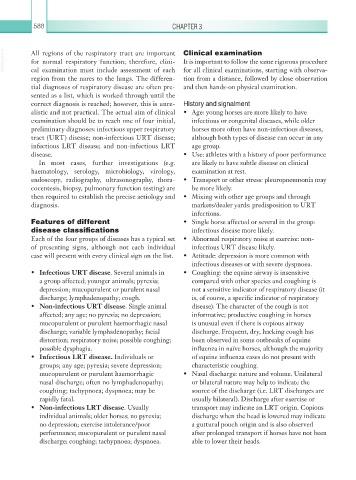Page 613 - Equine Clinical Medicine, Surgery and Reproduction, 2nd Edition
P. 613
588 CHAPTER 3
VetBooks.ir All regions of the respiratory tract are important Clinical examination
It is important to follow the same rigorous procedure
for normal respiratory function; therefore, clini-
cal examination must include assessment of each
tion from a distance, followed by close observation
region from the nares to the lungs. The differen- for all clinical examinations, starting with observa-
tial diagnoses of respiratory disease are often pre- and then hands-on physical examination.
sented as a list, which is worked through until the
correct diagnosis is reached; however, this is unre- History and signalment
alistic and not practical. The actual aim of clinical • Age: young horses are more likely to have
examination should be to reach one of four initial, infectious or congenital diseases, while older
preliminary diagnoses: infectious upper respiratory horses more often have non-infectious diseases,
tract (URT) disease; non-infectious URT disease; although both types of disease can occur in any
infectious LRT disease; and non-infectious LRT age group.
disease. • Use: athletes with a history of poor performance
In most cases, further investigations (e.g. are likely to have subtle disease on clinical
haematology, serology, microbiology, virology, examination at rest.
endoscopy, radiography, ultrasonography, thora- • Transport or other stress: pleuropneumonia may
cocentesis, biopsy, pulmonary function testing) are be more likely.
then required to establish the precise aetiology and • Mixing with other age groups and through
diagnosis. markets/dealer yards: predisposition to URT
infections.
Features of different • Single horse affected or several in the group:
disease classifications infectious disease more likely.
Each of the four groups of diseases has a typical set • Abnormal respiratory noise at exercise: non-
of presenting signs, although not each individual infectious URT disease likely.
case will present with every clinical sign on the list. • Attitude: depression is more common with
infectious diseases or with severe dyspnoea.
• Infectious URT disease. Several animals in • Coughing: the equine airway is insensitive
a group affected; younger animals; pyrexia; compared with other species and coughing is
depression; mucopurulent or purulent nasal not a sensitive indicator of respiratory disease (it
discharge; lymphadenopathy; cough. is, of course, a specific indicator of respiratory
• Non-infectious URT disease. Single animal disease). The character of the cough is not
affected; any age; no pyrexia; no depression; informative; productive coughing in horses
mucopurulent or purulent haemorrhagic nasal is unusual even if there is copious airway
discharge; variable lymphadenopathy; facial discharge. Frequent, dry, hacking cough has
distortion; respiratory noise; possible coughing; been observed in some outbreaks of equine
possible dysphagia. influenza in naïve horses, although the majority
• Infectious LRT disease. Individuals or of equine influenza cases do not present with
groups; any age; pyrexia; severe depression; characteristic coughing.
mucopurulent or purulent haemorrhagic • Nasal discharge: nature and volume. Unilateral
nasal discharge; often no lymphadenopathy; or bilateral nature may help to indicate the
coughing; tachypnoea; dyspnoea; may be source of the discharge (i.e. LRT discharges are
rapidly fatal. usually bilateral). Discharge after exercise or
• Non-infectious LRT disease. Usually transport may indicate an LRT origin. Copious
individual animals; older horses; no pyrexia; discharge when the head is lowered may indicate
no depression; exercise intolerance/poor a guttural pouch origin and is also observed
performance; mucopurulent or purulent nasal after prolonged transport if horses have not been
discharge; coughing; tachypnoea; dyspnoea. able to lower their heads.

